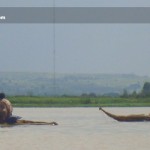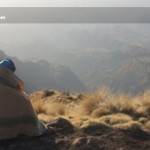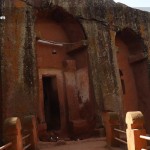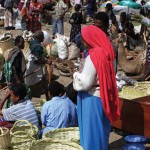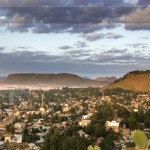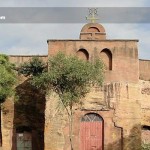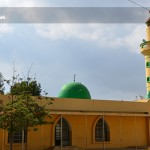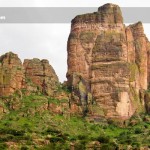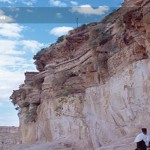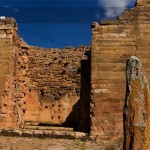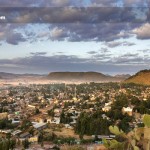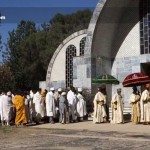In the center of Gondar city, the Royal Enclosure containing several medieval castles and churches lies surrounded by tall stone walls. This 70000 square meter compound contains a complex of buildings which includes Fasiladas’ castle, Iyasu’s palace, Dawit’s Hall, a banqueting hall, stables, Empress Mentewab’s castle, a chancery, library and three churches.
The original castle, built in 1640 by Emperor Fasiladas, is by far the most remarkable building within the compound. Built of stone and displaying a range of architectural influences such as Nubian, Arab, and Baroque styles, Fasliadas’ castle is an impressive achievement of architecture which served a double purpose as a palace as well as a defensible structure complete with gothic style ramparts and walkways.The site was inscribed as a UNESCO World Heritage Site in 1979 Fasiladas, credited with founding the city of Gondar in 1636, was proclaimed emperor in 1630 during a revolt led by Sartse Kirstos, but did not reach the throne until his father abdicated in 1632. Once he became emperor, Fasiladas immediately restored the official status of the traditional Ethiopian Orthodox Church expelling the Jesuits and restoring the ancient relationship that had been allowed to lapse with the Patriarch of Alexandria.
Aside from the castle at Fasil Ghebbi, he had constructed some of the earliest of Gondar’s fabled 44 churches. He is also credited with building seven stone bridges in Ethiopia; as a result all old bridges in Ethiopia are often commonly believed to be his work. Emperor Fasiladas also built the Cathedral Church of St Mary of Zion at Axum. Fasiladas’ church is known today as the “Old Cathedral” and stands next to a newer cathedral built by Emperor Haile Selassie.
Fasil Ghebbi is enclosed by a curtain wall which is pierced by twelve gates. These are, in counter-clockwise order: Fit Ber (also called Jan Tekel Ber) opening onto Adababay; Wember Ber (Gate of the Judges); Tazkar Ber (Gate of Funeral Commemoration), which had a bridge destroyed by fighting during the reign of Iyasu II; Azaj Tequr Ber which once was connected by a bridge to Adababay Tekle Haimanot church; Adenager Ber (Gate of the Spinners), which was linked by a bridge to Kidus Rafael church in the weaver’s section of Gondar; Qwali Ber (Gate of the Queen’s Attendants), next to the modern entrance to Elfign Giorgis church inside the enclosure; Embilta Ber (Gate of the Musicians); Elfign Ber (Gate of the Privy Chamber), which gave access to the private apartments of the Fasil Ghebbi; Balderas Ber (Gate of the Commander of the Cavalry); Ras Ber (Gate of the Ras), also known as Qwaregnyoch Ber (Gate of the Qwara people); Ergeb Ber (Gate of Pigeons), also known as Kechin Ashawa Ber (Gate of the Gifts); Enqoye Ber (Gate of Princess Enqoye, the mother of Empress Mentewab; and Gimjabet Mariam Ber (Gate of the Treasury of Mary), which leads to the church yard of Gimjabet Mariam church.
Out side the Royal Enclosure, there are several buildings of the same era and architecture. Emperor Fasiladas’ Bath, Empress Mentewab’s compound found at Qusquam, Ras Mikael Sahlu’s compound and Debre Birhan Selassie are the major ones. Emperor Fasiladas’ Bath- is a charming spot enclosed by a tall stone wall with six turrets, where the pool is overlooked by a two-storey building said to have been the Emperor’s second residence. Entrance fee to the pool is included with the Royal Enclosure and you can easily walk to the pool from the city center. The very colorful Ethiopian Orthodox Church Timkat Festival (Ethiopian Epiphany) is celebrated on January every year in Gondar around this pool. The ceremony is led by colorfully attired priests carrying the replica of the Ark of the Covenant and crosses, whereas thousands of whiterobbed worshippers converge around the pool to be blessed and sprinkled with its holy water




